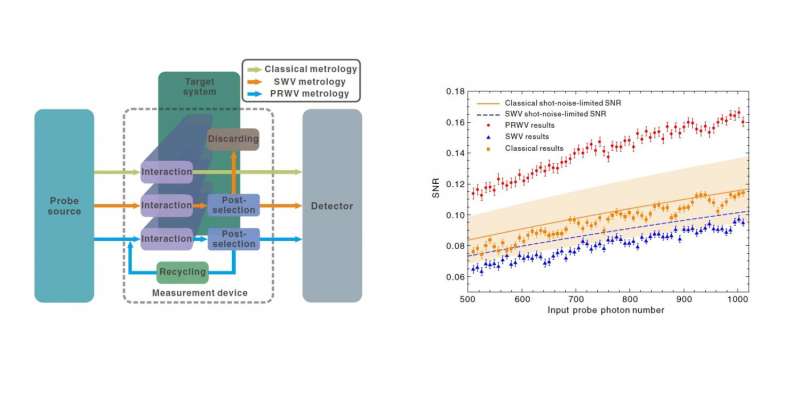December 14, 2016 feature
Weak-value-based metrology surpasses classical limit

(Phys.org)—When measuring very small physical effects, such as the deflection of a light beam, the very act of measuring can affect the measurement outcome. Now in a new study, physicists have experimentally demonstrated that a method designed to address this problem, called weak-value-based measurement, can, when strengthened by a recently proposed technique called power recycling, surpass the classical measurement limit and offer significant advantages for making ultra-precise quantum measurements.
The researchers, led by Chuan-Feng Li and Guang-Can Guo at the University of Science and Technology of China, have published a paper on the new demonstration in a recent issue of Physical Review Letters.
Weak-value-based metrology was first proposed in 1988 by physicists Yakir Aharonov, David Albert, and Lev Vaidman. In this method, the measurement device is only weakly coupled to the quantum system to be measured, which reduces the interference of the measurement on the system. The measurement is also made after the effect occurs, a strategy called postselection.
Over the past few decades, researchers have found that weak-value-based metrology can improve measurement sensitivity through signal amplification when measuring a variety of types of quantum systems. However, it suffers from a tradeoff, in that the postselection that helps amplify the signal also causes probe loss, meaning fewer photons are available to make the measurement. Due to probe loss, some recent research has suggested that the ultimate precision of weak-value-based metrology cannot exceed the classical metrology limit, calling into question the advantages of weak-value-based metrology.
The new study marks the first time that a weak-value-based measurement has surpassed the upper classical limit. The classical limit corresponds to the shot-noise limit, which is based on the particle nature of light, where random fluctuations caused by individual photons interfere with the measurement precision.
To overcome this limit, the researchers used a technique called power recycling, which, as its name suggests, makes full use of the wasted probe by recycling it. The scientists implemented the technique in a beam-deflection experiment by reflecting the unpostselected photons (which would otherwise be discarded) off a mirror, sending them back into the measurement device. Using power recycling, the signal is amplified as before, but probe loss is significantly reduced, resulting in a significantly higher precision.
"Our work provides a new type of high-precision metrology that will not only greatly enhance the measurement sensitivity (taking advantage of the weak-value-amplification technique), but also provide higher precision even surpassing the classical measurement limit (due to the power-recycling technique)," Li told Phys.org. "Our work for the first time demonstrates that weak-value-based metrology can go beyond classical metrology when the measurement probe is efficiently utilized."
The physicists expect that power-recycled weak-value-based metrology can be used to measure many other physical effects besides beam deflection.
"Weak-value-based metrology can be employed in the measurement of many very small physical effects, such as beam deflection, phase shifts, frequency shifts, temperature shifts, velocity measurements, and others, and even applied for gravitational-wave detection," Li said. "When combined with the power-recycling technique, weak-value-based metrology will show much higher measurement precision and more extensive application in measurement."
The researchers also expect that the measurement precision may be further improved by combining power recycling with other techniques, such as a multibounce pulse-recycling strategy in which multiple reflections enhance the measurement precision.
"Our future research will concentrate on increasing the measurement precision to reach the Heisenberg limit," Li said.
More information: Yi-Tao Wang et al. "Experimental Demonstration of Higher Precision Weak-Value-Based Metrology Using Power Recycling." Physical Review Letters. DOI: 10.1103/PhysRevLett.117.230801
Journal information: Physical Review Letters
© 2016 Phys.org

















